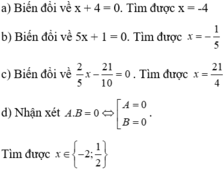Hãy nhập câu hỏi của bạn vào đây, nếu là tài khoản VIP, bạn sẽ được ưu tiên trả lời.

Đặt 
Suy ra 
Phương trình đã cho trở thành:
0,05.2u = 3,3 − u ⇔ 0,1u = 3,3 – u ⇔ 1,1u = 3,3 ⇔ u = 3.
Do đó: 

⇔ x – 2010 = 0
⇔ x = 2010.

Nếu đặt u = x 2 − 1 thì x 2 = u + 1 nên phương trình có dạng
( 2 + 2)u = 2(u + 1) − 2 (1)
Ta giải phương trình (1):
(1) ⇔ 2 u + 2u = 2u + 2 − 2
⇔ 2 u = 2 − 2
⇔ 2 u = 2 ( 2 − 1) ⇔ u = 2 − 1
⇔ x 2 − 1 = 2 − 1
⇔ x 2 = 2
⇔ x = 1

a/ \(\dfrac{6\left(16x+3\right)}{7}-8=\dfrac{3\left(16x+3\right)}{7}+7\)
\(\Leftrightarrow6\left(16x+3\right)-56=3\left(16x+3\right)+49\)
\(\Leftrightarrow96x+18-56-48x-9-49=0\)
\(\Leftrightarrow48x=96\)
\(\Leftrightarrow x=2\)
Vậy phương trình đã cho có nghiệm x=2
a) Đặt u = \(\dfrac{16x+3}{7}\), ta có:
\(\dfrac{6\left(16x+3\right)}{7}\) - 8 = \(\dfrac{3\left(16x+3\right)}{7}\) + 7
<=> 6.u - 8 = 3.u + 7
=> 6.u - 3.u = 8 + 7
=> 3.u = 15
=> u = 15 / 3
=> u = 5
<=> \(\dfrac{16x+3}{7}\) = 5
=> 16x + 3 = 5 . 7
=> 16x = 35 - 3
=> 16x = 32
=> x = 32 / 16
=> x = 2
Vậy S = { 2 }.

d: \(x\left(x+1\right)\left(x^2+x+1\right)=42\left(1\right)\)
=>\(\left(x^2+x\right)\left(x^2+x+1\right)=42\)
Đặt \(a=x^2+x\)
Phương trình (1) sẽ trở thành \(a\left(a+1\right)=42\)
=>\(a^2+a-42=0\)
=>(a+7)(a-6)=0
=>\(\left(x^2+x+7\right)\left(x^2+x-6\right)=0\)
mà \(x^2+x+7=\left(x+\dfrac{1}{2}\right)^2+\dfrac{27}{4}>0\forall x\)
nên \(x^2+x-6=0\)
=>(x+3)(x-2)=0
=>\(\left[{}\begin{matrix}x+3=0\\x-2=0\end{matrix}\right.\Leftrightarrow\left[{}\begin{matrix}x=-3\\x=2\end{matrix}\right.\)
e: \(\left(x-1\right)\left(x-3\right)\left(x+5\right)\left(x+7\right)-297=0\left(2\right)\)
=>\(\left(x-1\right)\left(x+5\right)\left(x-3\right)\left(x+7\right)-297=0\)
=>\(\left(x^2+4x-5\right)\left(x^2+4x-21\right)-297=0\)
Đặt \(b=x^2+4x\)
Phương trình (2) sẽ trở thành \(\left(b-5\right)\left(b-21\right)-297=0\)
=>\(b^2-26b+105-297=0\)
=>\(b^2-26b-192=0\)
=>(b-32)(b+6)=0
=>\(\left(x^2+4x-32\right)\left(x^2+4x+6\right)=0\)
mà \(x^2+4x+6=\left(x+2\right)^2+2>0\forall x\)
nên \(x^2+4x-32=0\)
=>(x+8)(x-4)=0
=>\(\left[{}\begin{matrix}x+8=0\\x-4=0\end{matrix}\right.\Leftrightarrow\left[{}\begin{matrix}x=-8\\x=4\end{matrix}\right.\)
f: \(x^4-2x^2-144x-1295=0\)
=>\(x^4-7x^3+7x^3-49x^2+47x^2-329x+185x-1295=0\)
=>\(\left(x-7\right)\cdot\left(x^3+7x^2+47x+185\right)=0\)
=>\(\left(x-7\right)\left(x+5\right)\left(x^2+2x+37\right)=0\)
mà \(x^2+2x+37=\left(x+1\right)^2+36>0\forall x\)
nên (x-7)(x+5)=0
=>\(\left[{}\begin{matrix}x-7=0\\x+5=0\end{matrix}\right.\Leftrightarrow\left[{}\begin{matrix}x=7\\x=-5\end{matrix}\right.\)

\(a,\dfrac{x-3}{x}=\dfrac{x-3}{x+3}\)\(\left(đk:x\ne0,-3\right)\)
\(\Leftrightarrow\dfrac{x-3}{x}-\dfrac{x-3}{x+3}=0\)
\(\Leftrightarrow\dfrac{\left(x-3\right)\left(x+3\right)-x\left(x-3\right)}{x\left(x+3\right)}=0\)
\(\Leftrightarrow x^2-9-x^2+3x=0\)
\(\Leftrightarrow3x-9=0\)
\(\Leftrightarrow3x=9\)
\(\Leftrightarrow x=3\left(n\right)\)
Vậy \(S=\left\{3\right\}\)
\(b,\dfrac{4x-3}{4}>\dfrac{3x-5}{3}-\dfrac{2x-7}{12}\)
\(\Leftrightarrow\dfrac{4x-3}{4}-\dfrac{3x-5}{3}+\dfrac{2x-7}{12}>0\)
\(\Leftrightarrow\dfrac{3\left(4x-3\right)-4\left(3x-5\right)+2x-7}{12}>0\)
\(\Leftrightarrow12x-9-12x+20+2x-7>0\)
\(\Leftrightarrow2x+4>0\)
\(\Leftrightarrow2x>-4\)
\(\Leftrightarrow x>-2\)

\(\left(x+4\right)\left(x^2-4x+16\right)-x\left(x-4\right)^2=8\left(x-3\right)\left(x+3\right)\)3)
\(\Leftrightarrow x^3+4^3-x\left(x-4\right)^2=8\left(x^2-3^2\right)\)
\(\Leftrightarrow x^3+64-x\left(x^2-8x+16\right)=8x^2-72\)
\(\Leftrightarrow x^3+64-x^3+8x^2-16x-8x^2-72=0\)
\(\Leftrightarrow-16x-8=0\)
\(\Leftrightarrow-8\left(2x-1\right)=0 \)
\(\Rightarrow2x-1=0\)
\(\Leftrightarrow2x=1\)
\(\Leftrightarrow x=\frac{1}{2}\)
Vậy \(x=\frac{1}{2}\)


1.
\(6+2x\ge3-x\)
\(\Leftrightarrow3x\ge-3\)
\(\Leftrightarrow x\ge-1\)
2.
\(2x+7>16-x\)
\(\Leftrightarrow3x>23\)
\(\Leftrightarrow x>\dfrac{23}{3}\)
3.
\(x-5< 3x+1\)
\(\Leftrightarrow2x>-6\)
\(\Leftrightarrow x>-3\)
Mik chưa học đến lớp 8 nên ko bt biểu diễn trên trục số nên chỉ tìm dc x thôi nha:
1. 6 + 2x \(\ge\) 3 - x
<=> 6 - 3 \(\ge\) -x - 2x
<=> 3 \(\ge\) -3x
<=> 3 : (-3) \(\ge\) -3x : (-3)
<=> -1 \(\le\) x
<=> x \(\ge\) -1
2. 2x + 7 > 16 - x
<=> 2x + x > 16 - 7
<=> 3x > 9
<=> 3x : 3 > 9 : 3
<=> x > 3
3. x - 5 < 3x + 1
<=> -5 - 1 < 3x - x
<=> -6 < 2x
<=> -6 : 2 < 2x : 2
<=> -3 < x
<=> x > (-3)

Đặt ta có phương trình 6u – 8 = 3u + 7.
ta có phương trình 6u – 8 = 3u + 7.
Giải phương trình này:
6u – 8 = 3u + 7
⇔ 6u – 3u = 7 + 8
⇔ 3u = 15 ⇔ u = 5
Vậy (16x + 3)/7 = 5 ⇔ 16x + 3 = 35
⇔ 16x = 32 ⇔ x = 2
⇔ (16x + 3)/7 = 5 ⇔ 16x + 3 = 35
⇔ 16x = 32 ⇔ x = 2